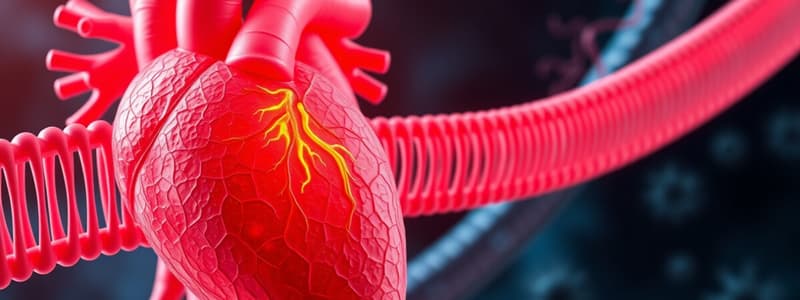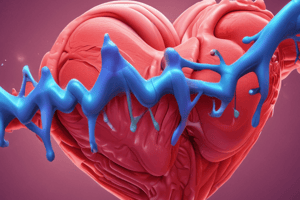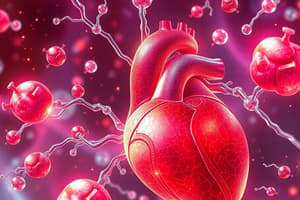Podcast
Questions and Answers
What is the primary focus of pathophysiology?
What is the primary focus of pathophysiology?
- The study of the structure of organisms and their parts
- The examination of chemical messengers between cells
- The investigation of the basic units of life
- The analysis of disordered physiological processes due to disease or injury (correct)
What component makes up the largest percentage of total body water in humans?
What component makes up the largest percentage of total body water in humans?
- Interstitial Fluid
- Plasma Volume
- Extracellular Fluid
- Intracellular Fluid (correct)
Which of the following correctly describes the function of hormones?
Which of the following correctly describes the function of hormones?
- They are broken down and carry signals over long distances
- They act as chemical messengers on distant target cells (correct)
- They only influence organs and cannot affect tissues
- They act on the same cell that produces them
How is Body Mass Index (BMI) calculated?
How is Body Mass Index (BMI) calculated?
What type of signaling is characterized by a chemical messenger produced by a cell that acts on itself?
What type of signaling is characterized by a chemical messenger produced by a cell that acts on itself?
What initiates an action potential?
What initiates an action potential?
How does the amplitude of an electronic potential change as it travels along the membrane?
How does the amplitude of an electronic potential change as it travels along the membrane?
What type of process is an action potential?
What type of process is an action potential?
During which period can no action potential be elicited, regardless of stimulus strength?
During which period can no action potential be elicited, regardless of stimulus strength?
Which of the following factors affects the conduction velocity of myelinated nerve fibers?
Which of the following factors affects the conduction velocity of myelinated nerve fibers?
In relation to axon diameter, where does conduction velocity tend to be faster?
In relation to axon diameter, where does conduction velocity tend to be faster?
What characteristic describes the response of an action potential?
What characteristic describes the response of an action potential?
What does the refractory region ensure during the propagation of action potentials?
What does the refractory region ensure during the propagation of action potentials?
What does a reflection coefficient (s) of 1 indicate about a solute's permeability through a membrane?
What does a reflection coefficient (s) of 1 indicate about a solute's permeability through a membrane?
Which statement correctly describes the role of the Na-K pump in cells?
Which statement correctly describes the role of the Na-K pump in cells?
What is the primary structure of cell membranes that limits the movement of solutes?
What is the primary structure of cell membranes that limits the movement of solutes?
According to Fick’s First Law, which factor influences the movement of solutes across a cell membrane the most?
According to Fick’s First Law, which factor influences the movement of solutes across a cell membrane the most?
In the context of osmosis, what does the term 'net water movement down the osmotic gradient' refer to?
In the context of osmosis, what does the term 'net water movement down the osmotic gradient' refer to?
What effect does digoxin have on intracellular sodium levels?
What effect does digoxin have on intracellular sodium levels?
Which ion concentration is typically high in intracellular fluids compared to extracellular fluids?
Which ion concentration is typically high in intracellular fluids compared to extracellular fluids?
How does the transmembrane potential typically behave in living cells?
How does the transmembrane potential typically behave in living cells?
What role do membrane carriers play in cellular function?
What role do membrane carriers play in cellular function?
What factor does NOT determine the diffusion potential of an ion across a membrane?
What factor does NOT determine the diffusion potential of an ion across a membrane?
What is the main consequence of digoxin's action on Na+/Ca2+ counter-transport?
What is the main consequence of digoxin's action on Na+/Ca2+ counter-transport?
Which of the following statements about channels is true?
Which of the following statements about channels is true?
Which ion is typically found at relatively high concentrations in extracellular fluid?
Which ion is typically found at relatively high concentrations in extracellular fluid?
What characterizes the relative refractory period of a neuron?
What characterizes the relative refractory period of a neuron?
Which of the following best describes the role of epithelial cells?
Which of the following best describes the role of epithelial cells?
In which type of epithelia is water permeability extremely low and insensitive to ADH?
In which type of epithelia is water permeability extremely low and insensitive to ADH?
What is passive tension in muscle contraction?
What is passive tension in muscle contraction?
Which mechanism regulates sodium transport in epithelial cells?
Which mechanism regulates sodium transport in epithelial cells?
How often can neurons typically fire action potentials under normal conditions?
How often can neurons typically fire action potentials under normal conditions?
Which type of muscle contraction does not involve motion?
Which type of muscle contraction does not involve motion?
Which of the following epithelia always has high water permeability and is not regulated?
Which of the following epithelia always has high water permeability and is not regulated?
What happens to a red blood cell in a hypotonic solution?
What happens to a red blood cell in a hypotonic solution?
What is the primary function of the Na-K pump in maintaining cellular homeostasis?
What is the primary function of the Na-K pump in maintaining cellular homeostasis?
Which of the following correctly describes an isosmotic solution?
Which of the following correctly describes an isosmotic solution?
How does active transport differ from passive diffusion?
How does active transport differ from passive diffusion?
What effect does the activation of the Na-K pump have on cell volume?
What effect does the activation of the Na-K pump have on cell volume?
What is the primary energy source for pumps like the Na-K pump in cellular transport?
What is the primary energy source for pumps like the Na-K pump in cellular transport?
Which statement is true regarding hypertonic solutions?
Which statement is true regarding hypertonic solutions?
What is the role of cardiac glycosides in relation to the Na-K pump?
What is the role of cardiac glycosides in relation to the Na-K pump?
What does a reflection coefficient (s) value of 0.5 indicate about a solute's permeability through a membrane?
What does a reflection coefficient (s) value of 0.5 indicate about a solute's permeability through a membrane?
Which statement accurately describes the role of the Na-K pump?
Which statement accurately describes the role of the Na-K pump?
What principle does Fick's First Law describe?
What principle does Fick's First Law describe?
What is a primary function of lipids in cell membranes?
What is a primary function of lipids in cell membranes?
What outcome is expected when a solute and water are freely permeable across a membrane?
What outcome is expected when a solute and water are freely permeable across a membrane?
What is the primary effect of an inward current on membrane potential?
What is the primary effect of an inward current on membrane potential?
What change occurs during the repolarizing phase of an action potential?
What change occurs during the repolarizing phase of an action potential?
What determines the amplitude of graded potentials?
What determines the amplitude of graded potentials?
How does hyperpolarization affect the membrane potential?
How does hyperpolarization affect the membrane potential?
What mechanism is primarily used by the Na-K ATPase pump?
What mechanism is primarily used by the Na-K ATPase pump?
Which ion permeability primarily influences the overshoot of an action potential?
Which ion permeability primarily influences the overshoot of an action potential?
What is a consequence of local graded potentials not reaching threshold?
What is a consequence of local graded potentials not reaching threshold?
What happens to membrane potential when gNa+ reaches high levels during an action potential?
What happens to membrane potential when gNa+ reaches high levels during an action potential?
What is the primary mechanism by which digoxin affects cardiac function?
What is the primary mechanism by which digoxin affects cardiac function?
Which of the following accurately describes the typical ion concentration gradients in living cells?
Which of the following accurately describes the typical ion concentration gradients in living cells?
Which statement correctly reflects the characteristics of membrane potential in excitable cells?
Which statement correctly reflects the characteristics of membrane potential in excitable cells?
What is the consequence of an increased intracellular Na+ level due to digoxin usage?
What is the consequence of an increased intracellular Na+ level due to digoxin usage?
Which factor does NOT influence the diffusion potential of ions across a membrane?
Which factor does NOT influence the diffusion potential of ions across a membrane?
In terms of cellular transport, what is a characteristic function of channel proteins?
In terms of cellular transport, what is a characteristic function of channel proteins?
What defines the electrical potential difference known as transmembrane potential?
What defines the electrical potential difference known as transmembrane potential?
Which condition best describes the effect of digoxin on cardiac muscle contraction?
Which condition best describes the effect of digoxin on cardiac muscle contraction?
What is the difference between electronic potential and action potential in terms of response type?
What is the difference between electronic potential and action potential in terms of response type?
How does myelination affect the conduction velocity of nerve fibers?
How does myelination affect the conduction velocity of nerve fibers?
What characterizes the absolute refractory period in action potential propagation?
What characterizes the absolute refractory period in action potential propagation?
In what way does the diameter of a nerve fiber relate to its conduction velocity?
In what way does the diameter of a nerve fiber relate to its conduction velocity?
What is a consequence of local circuit current flow during action potentials?
What is a consequence of local circuit current flow during action potentials?
How does the excitability of large diameter axons compare to small diameter axons?
How does the excitability of large diameter axons compare to small diameter axons?
What happens to the amplitude of action potentials as they travel along the membrane?
What happens to the amplitude of action potentials as they travel along the membrane?
What role does the refractory period play in the propagation of action potentials?
What role does the refractory period play in the propagation of action potentials?
Flashcards are hidden until you start studying
Study Notes
Digoxin and Cardiac Function
- Digoxin inhibits Na+/K+ ATPase, leading to increased intracellular sodium (Na+) and decreased sodium gradient.
- This results in a decreased Na+/Ca2+ counter-transport, ultimately increasing intracellular calcium (Ca2+).
- It has been a foundational treatment for heart failure and is currently the only oral inotropic agent in clinical use.
Cell Membrane Transport
- Carriers are enzyme-like proteins that create passive pathways for solutes to cross membranes along concentration gradients.
- Channels are ion-selective pores that open and close transiently, facilitating ionic movement based on electrical and chemical gradients.
- Signals in excitable cells are produced through channel activity that alters membrane potential.
Excitable Cells and Membrane Potential
- The transmembrane potential (Em) is the voltage difference across the cell membrane, typically negative inside relative to the outside.
- Em ranges from -10 mV to -100 mV in living cells, indicating high intracellular potassium (K+) and anionic protein levels, while sodium (Na+) and chloride (Cl-) are relatively low.
- Diffusion potential depends on ion charge, membrane permeability, and ion concentration differences.
Excitable Cells: Action Potential
- Action potentials are initiated by depolarization reaching a threshold, following a passive process dependent on membrane properties.
- The local circuit current maintains depolarization spread, increasing Na+ permeability as the threshold is met.
- Refractory regions help ensure action potentials propagate away from each other.
Nerve Fibers and Action Potential Propagation
- The speed of action potential conduction in nerve fibers is influenced by axon diameter and myelination.
- Larger diameter unmyelinated fibers conduct signals faster than smaller ones, while myelination significantly increases conduction velocity.
- Absolute refractory period prevents subsequent action potentials regardless of stimulus strength.
Cellular Physiology and Organization
- The human body is formed from ~100 trillion differentiated cells organized into tissues, organs, and organ systems.
- Hormones are chemical messengers acting on distant cells, while paracrine and autocrine signals target nearby and self cells, respectively.
Body Fluid Composition
- Body water content is approximately 57%, with variations (65-70% in infants).
- Total body water distribution: intracellular fluid (ICF) at ~63%, extracellular fluid (ECF) at ~37%, with interstitial fluid and plasma volumes noted.
Body Mass Index (BMI)
- BMI is calculated as weight (kg) divided by height (m²) and serves as a key metric for assessing obesity.
- Categories include underweight, normal weight, overweight, and obesity.
Cell Membrane Functions and Solute Movement
- Cell membranes regulate solute movement, with Fick’s First Law detailing solute diffusion across membranes.
- Lipid bilayers serve as barriers to water and water-soluble substances, while specific channels facilitate transport.
- Reflection coefficient indicates solute permeability through membranes, ranging from impermeable (s = 1) to highly permeable (s = 0).
Epithelial Transport Mechanics
- Epithelia act as barriers between internal and external environments, regulating fluid balance, nutrient absorption, and waste excretion.
- Na+ transport in epithelial cells can be intrinsic or extrinsic, adjusting to maintain electrolyte homeostasis.
- Epithelial water transport can vary significantly between regions, displaying high, low, or regulated permeability depending on specific needs.
Excitable Cells: Muscle Types
- Skeletal muscle exhibits isometric contractions without motion, characterized by passive and total tension measurements at various lengths.
- Active tension stems from cross-bridge cycling, while passive tension accumulates from muscle stretching.
Cell Volume Regulation and Na-K Pump
- Cells swell and burst without the Na-K pump, which transports 3 Na+ out for every 2 K+ in.
- Proteins and organic compounds inside cells are anionic, leading to cation accumulation and water influx.
- The Na-K pump is activated by a 15% increase in cell size.
Body Fluid Distribution: Tonicity
- Isotonic: No net fluid movement in or out of red blood cells.
- Hypotonic: Causes net fluid influx into red blood cells, leading to swelling or lysis.
- Hypertonic: Causes net fluid outflow, resulting in cell shrinkage.
- Isosmotic: Equal concentration of osmotically active particles across a semipermeable membrane.
Osmolarity vs Tonicity
- Osmolarity indicates concentration of solutes and varies with solute type (NaCl, Urea, CaCl2).
- NaCl concentrations and their corresponding osmolarity impact tonicity classifications (isotonic, hypertonic, hypotonic).
Cell Membrane Transport
- Diffusion: Passive transport, movement down a concentration gradient without energy.
- Active Transport: Involves energy and a "carrier" to move solutes against a concentration gradient.
Pumps and Membrane Carriers
- Pumps, like ATP-dependent Na-K pump, establish ion gradients and utilize energy (ATP).
- Cardiac glycosides inhibit Na-K ATPase, leading to increased intracellular Na+ and Ca2+ for heart function.
Reflection Coefficient
- Measures permeability of solute through membranes (ranges from 0 to 1), where 1 indicates complete impermeability.
Membrane Structure and Solute Movement
- Cell membranes limit solute movement, maintaining concentration gradients.
- Fick’s First Law describes solute movement across membranes, emphasizing permeability and concentration differences.
Ion Concentration Gradients in Excitable Cells
- High intracellular potassium (K+) and anionic proteins (Pr-); low sodium (Na+) and chloride (Cl-).
- Extracellular fluid is rich in Na+ and Cl-, almost devoid of K+.
Membrane Potential in Excitable Cells
- Transmembrane potential (Em) is negative inside relative to outside, typically between -10 mV to -100 mV.
- Changes in permeability to ions regulate Em; Na-K ATPase maintains homeostasis.
Graded and Action Potentials
- Graded Potential: Local depolarization that may not reach threshold; proportional to stimulus intensity.
- Action Potential: A rapid and all-or-nothing signal.
- Depolarizing phase caused by increased Na+ permeability; repolarizing phase by K+ efflux.
Excitable Cell Functionality
- Types include neurons, skeletal, cardiac, and smooth muscle.
- Action potentials are crucial for signaling and muscle contraction.
Membrane Potential Dynamics
- Depolarization increases Na+ permeability; hyperpolarization decreases it.
- Overshoot occurs when Em surpasses 0 mV, returning to repolarization.
Refractory Periods
- Absolute Refractory Period: No new action potential can be generated regardless of stimulus strength.
Factors Influencing Nerve Conduction
- Conduction velocity in nerve fibers is influenced by axon diameter and myelination.
- Myelinated fibers offer faster conduction due to insulated segments (internodal lengths).
Overall Functional Properties of Axons
- Large diameter axons enable fast conduction and high excitability, while smaller diameters result in slower conduction.
Studying That Suits You
Use AI to generate personalized quizzes and flashcards to suit your learning preferences.




